

 |
Search the Site with

|
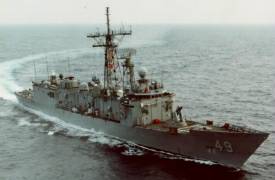 | 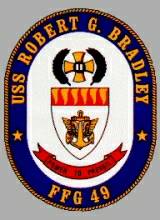 | 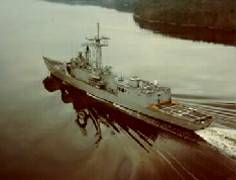 |
USS ROBERT G. BRADLEY was an OLIVER HAZARD PERRY class frigate and the first ship in the Navy to bear the name. The ship was decommissioned at Mayport, Fla., on March 28, 2014.
| General Characteristics: | Keel Laid: December 28, 1982 |
| Launched: August 13, 1983 | |
| Commissioned: August 11, 1984 | |
| Decommissioned: March 28, 2014 | |
| Builder: Bath Iron Works, Bath, Maine | |
| Propulsion system: two General Electric LM 2500 gas turbines, two 350 Horsepower Electric Drive Auxiliary Propulsion Units | |
| Propellers: one | |
| Blades on each Propeller: five | |
| Length: 453 feet (138 meters) | |
| Beam: 47 feet (14.32 meters) | |
| Draft: 24,6 feet (7.5 meters) | |
| Displacement: 4,100 tons | |
| Speed: 28+ knots | |
| Aircraft: two | |
| Armament: one | |
| Crew: 17 Officers and 198 Enlisted |
Crew List:
This section contains the names of sailors who served aboard USS ROBERT G. BRADLEY. It is no official listing but contains the names of sailors who submitted their information.
USS ROBERT G. BRADLEY in the News:
About the Frigate’s Name, about Lieutenant Robert Graham Bradley:
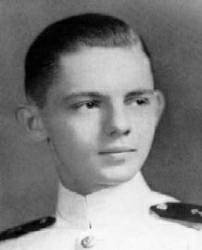 Robert Graham Bradley was born in Washington D.C. on 26 September 1921. He was appointed to the U.S. Naval Academy on 9 June 1939, and graduated with the class of 1943 on 19 June 1942, due to the exigencies of war. From 3 July to 27 October 1942, he underwent instruction at the Atlantic Subordinate Command, Service Force, at Norfolk, VA, before he reported to the New York Shipbuilding Corporation, Camden, NJ, on 29 October to assist in fitting out the fleet carrier USS PRINCETON (CVL 23), which was ultimately placed in commission on 25 February 1943. While serving on that ship, he received promotions to Lieutenant (junior grade) and Lieutenant on 1 May 1943 and 1 July 1944, respectively, and took part in every operation conducted by the ship ranging from the occupation of Baker Island (September 1943) to the Battle of Leyte Gulf (October 1944), in which the ship was lost.
Robert Graham Bradley was born in Washington D.C. on 26 September 1921. He was appointed to the U.S. Naval Academy on 9 June 1939, and graduated with the class of 1943 on 19 June 1942, due to the exigencies of war. From 3 July to 27 October 1942, he underwent instruction at the Atlantic Subordinate Command, Service Force, at Norfolk, VA, before he reported to the New York Shipbuilding Corporation, Camden, NJ, on 29 October to assist in fitting out the fleet carrier USS PRINCETON (CVL 23), which was ultimately placed in commission on 25 February 1943. While serving on that ship, he received promotions to Lieutenant (junior grade) and Lieutenant on 1 May 1943 and 1 July 1944, respectively, and took part in every operation conducted by the ship ranging from the occupation of Baker Island (September 1943) to the Battle of Leyte Gulf (October 1944), in which the ship was lost.
On 24 October 1944, PRINCETON was operating of the coast of Luzon, in the Leyte Gulf, about 150 miles east of Manila, when a Japanese dive bomber attacked her, releasing a single bomb that penetrated the flight hangar and main decks and then exploded, touching off a conflagration that soon had the carrier's entire hangar deck ablaze. A series of explosions then rocked the ship. Lieutenant Bradley, PRINCETON's Assistant First Lieutenant, led a repair party in the valiant effort to control the fires on the second and third decks until the intense heat generated by those flames forced him and his men to fall back. After ensuring that no wounded men had been left behind during the abandonment, Bradley followed his men into the water at about 1005 and was picked up by the destroyer MORRISON (DD 560) soon thereafter.
Shortly before 1300, Bradley left MORRISON and rejoined his ship and the efforts to save her. Unfortunately a submarine and air alert at 1330 drew off BIRMINGHAM (CL 62) and MORRISON -- the two ships then alongside -- to assume screening positions, at a time when the fire was almost totally under control. The persistent blazed flared up. With renewed vigor MORRISON and BIRMINGHAM attempted to renew their efforts alongside PRINCETON getting a line onboard the carrier at about 1515. Shortly thereafter, at 1523, the flames touched off a mass detonation of four hundred 100-pound bombs stowed aft in a torpedo magazine in PRINCETON. This explosion literally blew off the carrier's stern, killing Bradley and every man in the repair party that had been in the vicinity.
Bradley had repeatedly risked his life, entering the most dangerous areas below decks to ascertain the extent of damage and to fight the fires blazing onboard ship. For his outstanding fortitude, great personal valor and self-sacrificing devotion to the completion of an extremely perilous task, as well as his extraordinary heroism in the line of duty, Lieutenant Robert Graham Bradley was awarded the Navy Cross, posthumously.
USS ROBERT G. BRADLEY Cruise Books:
USS ROBERT G. BRADLEY Patch Gallery:
 | 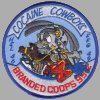 |  |
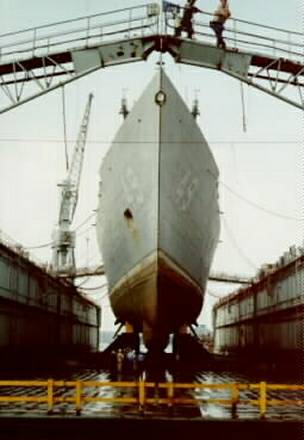 | 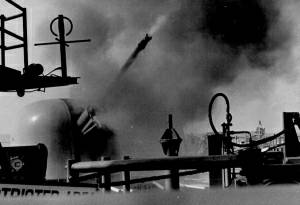 |
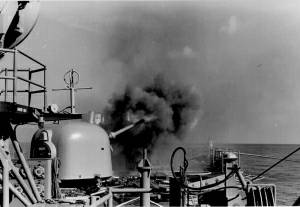 |
About the Ship's Coat of Arms:
 The Shield:
The Shield:
Gold and dark blue are the colors traditionally associated with the Navy. The winged anchor refers to Lt. Bradley’s service on board small aircraft carrier PRINCETON (CVL 23) during World War II. The flaming chief symbolizes the damage inflicted aboard PRINCETON by a Japanese aerial attack during the Battle of Leyte Gulf, and resulting fires which claimed Bradley’s life as he valiantly led a repair party in the effort to extinguish the flames and save the ship.
The Crest:
The cross is gold, symbolic of excellence and glory, and refers to the Navy Cross awarded posthumously to Bradley for his supreme effort and sacrifice in the battle to save PRINCETON. The two bars at the center are white for purity and nobility of purpose, recognizing the face that Bradley, although aware of the eminent danger, returned to the abandoned ship a second time with a salvage crew when an explosion touched off by the flames took their lives. The palm branch on either side of the cross symbolizes the courage that Bradley displayed in leading the salvage effort on board PRINCETON.
USS ROBERT G. BRADLEY Image Gallery:
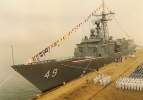 | 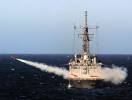 | 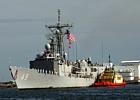 | 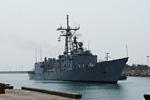 | 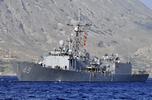 |
The photos below were taken by Michael Nebel and show the ROBERT G. BRADLEY during a port visit to Malaga, Spain, April 2-5, 1995. Malaga was the ship's last port visit before returning home to Naval Base Charleston, SC., following a 6-month Mediterranean deployment. During the deployment, the ROBERT G. BRADLEY became the first US Navy ship to ever visit Slovenia when she stopped at Koper, Slovenia, March 2-5, 1995.
 | 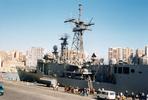 | 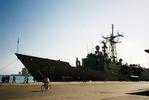 | 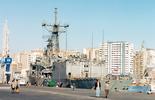 | 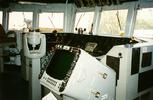 |
The photos below were taken by me during ROBERT G. BRADLEY's port visit to Kiel, Germany, from June 16 - 19, 2006. The port visit marked the end of BALTOPS 2006.
 |  | 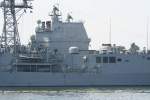 | 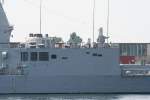 | 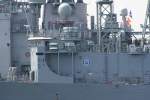 |
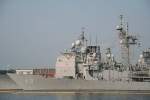 | 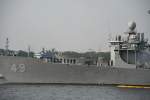 | 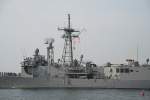 | 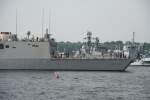 |  |
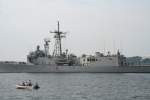 | 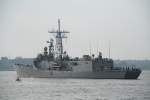 |
The photo below was taken by Carl Groll and shows the ROBERT G. BRADLEY getting mooring assistance by the tugs after arriving at Kiel, Germany, on June 16, 2006.
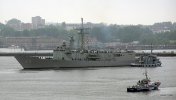 |
The photos below were taken by Michael Jenning and show the ROBERT G. BRADLEY laid up among her sisterships at the former Philadelphia Naval Shipyard. The photos were taken on October 21, 2014.
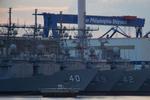 | 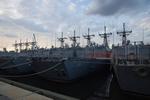 |  | 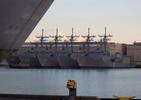 |
The photos below were taken by Michael Jenning and show the ROBERT G. BRADLEY laid up alongside her sisterships at the former Philadelphia Naval Shipyard. The photos were taken on October 16, 2015.
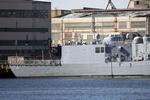 | 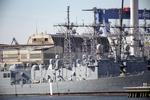 | 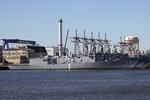 | 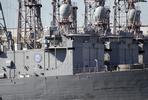 |
The photo below was taken by Michael Jenning and shows the ROBERT G. BRADLEY laid up at the former Philadelphia Naval Shipyard on October 7, 2018.
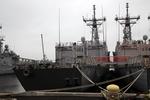 |
 Back to Frigates list.
Back to Frigates list.  Back to ships list.
Back to ships list.  Back to selection page.
Back to selection page.  Back to 1st page.
Back to 1st page.